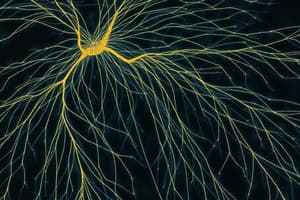Podcast
Questions and Answers
If a toxin disrupted microtubule function, what is most likely to be affected?
If a toxin disrupted microtubule function, what is most likely to be affected?
Anaphase
Where are lysosomes produced?
Where are lysosomes produced?
Golgi
What is the function of a lysosome?
What is the function of a lysosome?
Contains digestive enzymes for breaking down nutrients, cell debris, and bacteria
What is the functional equivalent of the lysosome in plants?
What is the functional equivalent of the lysosome in plants?
What are four possible places where microfilaments can be found?
What are four possible places where microfilaments can be found?
What is a bacterial flagellum composed of?
What is a bacterial flagellum composed of?
What is Clathrin?
What is Clathrin?
What is a nucleoid region?
What is a nucleoid region?
What are teichoic acids?
What are teichoic acids?
During conjugation, what does the donor bacteria contain?
During conjugation, what does the donor bacteria contain?
Which of the following best defines a notochord?
Which of the following best defines a notochord?
What are the four main features during their development that chordates share?
What are the four main features during their development that chordates share?
What are the characteristics of Nematoda?
What are the characteristics of Nematoda?
What are the characteristics of Annelida?
What are the characteristics of Annelida?
What are the characteristics of Mollusca?
What are the characteristics of Mollusca?
What are the characteristics of Echinodermata?
What are the characteristics of Echinodermata?
What are the characteristics of Platylhelminthes?
What are the characteristics of Platylhelminthes?
Blood in the pulmonary vein would be best characterized as which of the following?
Blood in the pulmonary vein would be best characterized as which of the following?
In mammals, which of the following structures aides the embryo in gas exchange and the disposal of liquid waste?
In mammals, which of the following structures aides the embryo in gas exchange and the disposal of liquid waste?
A species of desert plant secretes a chemical into the surrounding soil that kills seeds from any other species of plant that attempts to germinate in that area. What is this an example of?
A species of desert plant secretes a chemical into the surrounding soil that kills seeds from any other species of plant that attempts to germinate in that area. What is this an example of?
What is allelopathy?
What is allelopathy?
What is exploitation competition?
What is exploitation competition?
What is apparent competition?
What is apparent competition?
Flashcards are hidden until you start studying
Study Notes
Microtubules and Cell Division
- Disruption of microtubule function primarily impacts anaphase during cell division.
Lysosomes
- Lysosomes are produced in the Golgi apparatus.
- They contain digestive enzymes necessary for breaking down nutrients, cell debris, and bacteria.
- In plants, the functional equivalent of lysosomes is the central vacuole.
Microfilaments
- Microfilaments can be found in muscle cells, pseudopods of amoebas, cleavage furrows during animal cell division, and as part of the cytoskeleton.
Bacterial Structures
- Bacterial flagella are composed of the protein flagellin.
- The nucleoid region is where the DNA of bacterial cells is located, given the absence of a nucleus.
- Teichoic acids are unique to gram-positive bacteria, helping maintain cell wall rigidity and serving as binding sites for bacterial viruses.
- During conjugation, donor bacteria possess the F plasmid.
Chordate Development
- Notochord is a cartilaginous structure that will develop into the spine.
- Key developmental features of chordates include the notochord, dorsal hollow nerve cord, pharyngeal gill slits, and muscular post-anal tail.
Animal Phyla Characteristics
- Nematoda: Complete digestive system, bilateral symmetry, pseudocoelomates, often parasitic, characterized by a protective cuticle (e.g., roundworms, hookworms).
- Annelida: Complete digestive system, bilateral symmetry, coelomates, segmented bodies, closed circulatory systems (e.g., earthworms, leeches).
- Mollusca: Complete digestive system, bilateral symmetry, coelomates with an open circulatory system (except cephalopods), possess a radula (e.g., clams, snails, squids).
- Echinodermata: Complete digestive system, radial symmetry, coelomates, open circulatory system, classified as deuterostomes (e.g., starfish, sea urchins).
- Platyhelminthes: Incomplete digestive system with a gastrovascular cavity, bilateral symmetry, acoelomate (e.g., flatworms, tapeworms).
Blood and Embryonic Structures
- Blood in the pulmonary vein is characterized by high oxygen (O2) content.
- The allantois aids embryos in gas exchange and disposal of liquid waste in mammals.
Competition Types
- Allelopathy involves a plant releasing chemicals to inhibit the germination of other plant species, showcasing interference competition.
- Exploitation competition occurs indirectly through depletion of resources; for instance, lions and cheetahs competing for a limited gazelle population.
- Apparent competition arises when two species compete indirectly via a shared predator.
Studying That Suits You
Use AI to generate personalized quizzes and flashcards to suit your learning preferences.




